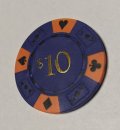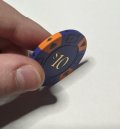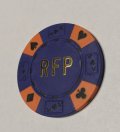This is my first post here and I just recently started collecting chips.
I recently came into a large number of blue $10 chips gold stamped with RFP. I received them in a box of chips with others that I suspect were from a closed down local cardroom. I have never come across 10$ chips before but they are clearly well made and held up the test of time with nearly all of them in very good+ condition. I noticed there is a small manufacturing mark / circle on the inner indent circle on the $10 side of every one of them. The lettering is very shiny and indented into the chip (not just painted on.) They are as heavy as any cardroom / casino chip I've ever played with. Anyone know more about this style of chip or what it might be made of?
I have attached some photos. Thanks!
I recently came into a large number of blue $10 chips gold stamped with RFP. I received them in a box of chips with others that I suspect were from a closed down local cardroom. I have never come across 10$ chips before but they are clearly well made and held up the test of time with nearly all of them in very good+ condition. I noticed there is a small manufacturing mark / circle on the inner indent circle on the $10 side of every one of them. The lettering is very shiny and indented into the chip (not just painted on.) They are as heavy as any cardroom / casino chip I've ever played with. Anyone know more about this style of chip or what it might be made of?
I have attached some photos. Thanks!



